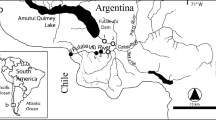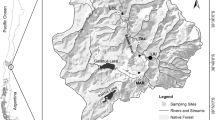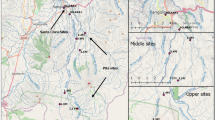Abstract
This study aims to assess the ecological profile of the invasive alga Didymosphenia geminata in NW Spain, analysing the biotic and abiotic factors related to the presence of massive colonies and their effect on river benthos. Physical and chemical parameters were measured in three infested rivers during 2009 and 2010, and biological samples of benthic community were taken according to standard protocols. Collected data was compared with that of control stations located in the same rivers but presenting no evident infestations. The autoecology shown by D. geminata in this study supports former observations reporting the expansion of its ecological niche, with current velocity and nutrients concentrations the environmental variables that best explain the establishment and development of mats in the studied rivers. Regarding its impact, it was observed that the mass growths of this diatom produced a dramatic change in the composition of the algae and macroinvertebrate benthic community which persisted after their disappearance. These results led to the development of a geostatistical predictive model to identify potential risk of dispersion of this diatom in Spanish rivers. The expected distribution of this algae according to this model agreed in general with the actual observed infestations, thus validating it as a tool to prevent and manage future infestations.










Similar content being viewed by others
Abbreviations
- AFDW:
-
Phytobenthic ash-free dry weight
- Chla :
-
Phytobenthic chlorophyll a
- Cond:
-
Specific electric conductivity
- CV:
-
Current velocity
- DGEM:
-
Didymosphenia geminata
- DW:
-
Phytobenthic dry weight
- TKN:
-
Kjeldahl nitrogen
- Phae:
-
Phytobenthic photosynthetically active phaeopigments
- SRP:
-
Soluble reactive phosphorus
- T:
-
Temperature
- TOC:
-
Total organic carbon
- TP:
-
Total phosphorus
References
Aboal M, Marco S, Chaves E, Mulero I, García-Ayala A (2012) Ultrastructure and function of stalks of the diatom Didymosphenia geminata. Hydrobiologia 695:17–24
AENOR (2004) Norma española UNE–EN 13946:2004. Calidad del agua. Guía para el muestreo en rutina y el pretratamiento de diatomeas bentónicas de ríos. AENOR, Madrid
AENOR (2005) Norma española UNE–EN 14407:2005. Calidad del agua. Guía para la identificación, recuento e interpretación de muestras de diatomeas bentónicas de ríos. AENOR, Madrid
Alba Tercedor J, Jáimez-Cuéllar P, Álvarez M, Avilés J, Bonada N, Casas J, Mellado A, Ortega M, Pardo I, Prat N, Rieradevall M, Robles S, Sáinz-Cantero CE, Sánchez-Ortega A, Suárez ML, Toro M, Vidal-Abarca MR, Vivas S, Zamora-Muñoz C (2002) Caracterización del estado ecológico de ríos mediterráneos ibéricos mediante el índice IBMWP (antes BMWP’). Limnetica 21:175–185
Álvarez I, Escudero A, Cejudo C, Pérez M, Blanco S, Bécares E (2010) Control y seguimiento del alga invasora Didymosphenia geminata. CHD, Valladolid
APHA (2005) Standard methods for the examination of water and wastewater. American Water Works Association, Washington
Beeby J (2012) Water quality and survivability of Didymosphenia geminata. Colorado State University, Fort Collins
Beltrami ME, Blanco S, Ciutti F, Cappelletti C, Monauni C, Pozzi S, Rimet F, Ector L (2008) Distribution and ecology of Didymosphenia geminata (Lyngbye) M. Schmidt (Bacillariophyta) in Trentino watercourses (northern Italy). Cryptogam Algol 29:141–160
Berkson J (1944) Application of the logistic function to bio-assay. J Am Stat Assoc 39:357–365
Beville ST, Kerr GN, Hughey KFD (2012) Valuing impacts of the invasive alga Didymosphenia geminata on recreational angling. Ecol Econ 82:1–10
Blanco S, Ector L (2008) Didymosphenia geminata (Bacillariophyta, Gomphonemataceae), una amenaza para nuestros ríos. Cuad Biodivers 26:3–6
Blanco S, Ector L (2009) Distribution, ecology and nuisance effects of the freshwater invasive diatom Didymosphenia geminata (Lyngbye) M. Schmidt: a literature review. Nova Hedwig 88:347–422
Blanco S, Ector L, Huck V, Monnier O, Cauchie HM, Hoffmann L, Bécares E (2008) Diatom assemblages and water quality assessment in the Duero basin (NW Spain). Belg J Bot 141:39–50
Bland JM, Kerry SM (1998) Weighted comparison of means. BMJ 316:129
Campbell ML (2005) Organism impact assessment (OIA) for potential impacts of Didymosphenia geminata. All Oceans Ecology, Melbourne
CHE (2005) Metodología para el establecimiento del estado ecológico, según la Directiva Marco del Agua: protocolos de muestreo y análisis para fitobentos (microalgas bentónicas). CHE, Zaragoza
Clarke KR (1993) Non-parametric multivariate analyses of changes in community structure. Austr J Ecol 18:117–143
Corbett LM (2013) Relationships between Didymosphenia geminata occurrence, blooms and environmental conditions. Ph.D. Thesis, Univ Calgary
Coste M (1982) Etude des méthodes biologiques d’appréciation quantitative de la qualité des eaux. Report (CEMAGREF) QE Lyon–AF Bassin Rhône–Méditérannée–Corse
Coste M, Ector L (2000) Diatomées invasives exotiques ou rares en France: principales observations effectuées au cours des dernières décennies. Syst Geograph Plants 70:373–400
Cullis JDS, Gillis C-A, Bothwell ML, Kilroy C, Packman A, Hassan M (2012) A conceptual model for the blooming behavior and persistence of the benthic mat-forming diatom Didymosphenia geminata in oligotrophic streams. J Geophys Res 117:G00N03
Cullis JDS, Crimaldi JP, McKnight DM (2013) Hydrodynamic shear removal of the nuisance stalk-forming diatom Didymosphenia geminata. Limnol Oceanogr 3:256–268
Cullis JDS, McKnight DM, Spaulding SA (2015) Hydrodynamic control of benthic mats of Didymosphenia geminata at the reach scale. Can J Fish Aquat Sci 72:902–914
Ellwood NTW, Whitton BA (2007) Importance of organic phosphate hydrolyzed in stalks of the lotic diatom Didymosphenia geminata and the possible impact of atmospheric and climatic changes. Hydrobiologia 592:121–133
Elwell L (2006) Increase in nuisance blooms and geographic expansion of the freshwater diatom Didymosphenia geminata: recommendations for response. Federation of Fly Fishers, Livingston
Elwell LC, Gillis C-A, Kunza LA, Modley MD (2014) Management challenges of Didymosphenia geminata. Diatom Res 29:303–305
Falasco E, Bona F (2013) Recent findings regarding non-native or poorly known diatom taxa in north-western Italian rivers. J Limnol 72:e4
Freeman C, Lock MA (1995) The biofilm polysaccharide matrix: A buffer against changing organic substrate supply? Limnol Oceanogr 40:273–278
Furey PC, Kupferberg SJ, Lind AJ (2014) The perils of unpalatable periphyton: Didymosphenia and other mucilaginous stalked diatoms as food for tadpoles. Diatom Res 29:267–280
Gillis C-A, Chalifour M (2010) Changes in the macrobenthic community structure following the introduction of the invasive algae Didymosphenia geminata in the Matapedia River (Québec, Canada). Hydrobiologia 647:63–70
Gillis C-A, Lavoie I (2014) A preliminary assessment of the effects of Didymosphenia geminata nuisance growths on the structure and diversity of diatom assemblages of the Restigouche River basin, Quebec, Canada. Diatom Res 29:281–292
Hammer Ø, Harper DAT, Ryan PD (2001) PAST: Palaeontological Statistics software package for education and data analysis. Palaeontol Electron 4:1–9
Hansson LA, Gyllström M, Ståhl-Delbanco A, Svensson M (2004) Responses to fish predation and nutrients by plankton at different levels of taxonomic resolution. Freshw Biol 49:1538–1550
Hoagland KD, Rosowski JR, Gretz MR, Roemer SC (1993) Review—diatom extracellular polymeric substances: function, fine structure, chemistry, and physiology. J Phycol 29:537–566
Holderman C, Hardy R (2004) Kootenai River Ecosystem Project: an ecosystem approach to evaluate and rehabilitate a degraded, large riverine ecosystem. Final Report to Bonneville Power Administration, pp 49–99
Hustedt F (1930) Bacillariophyta (Diatomeae). Die Süsswasser-Flora Mitteleuropas. Gustav Fischer, Jena, pp 1–466
James DA (2013) Risk potential for the aquatic invasive species Didymosphenia geminata to bloom in selected streams of the Black Hills, South Dakota. U.S. Fish and Wildlife Service, Colorado
James DA, Ranney SH, Chipps SR, Spindler BD (2010) Invertebrate composition and abundance associated with Didymosphenia geminata in a montane stream. J Freshw Ecol 25:235–241
Kawecka B, Sanecki J (2003) Didymosphenia geminata in running waters of southern Poland—symptoms of change in water quality? Hydrobiologia 495:193–201
Kilroy C, Bothwell ML (2012) Didymosphenia geminata growth rates and bloom formation in relation to ambient dissolved phosphorus concentration: ambient phosphorus and Didymosphenia geminata blooms. Freshw Biol 57:641–653
Kilroy C, Bothwell ML (2014) Attachment and short-term stalk development of Didymosphenia geminata: effects of light, temperature and nutrients. Diatom Res 29:237–248
Kilroy C, Unwin M (2011) The arrival and spread of the bloom-forming, freshwater diatom, Didymosphenia geminata, in New Zealand. Aquat Invas 6:249–262
Kilroy C, Biggs B, Blair N, Lambert P, Jarvie B, Dey K, Smale D (2005) Ecological studies on Didymosphenia geminata. National Institute for Water and Atmospheric Research, Christchurch
Kilroy C, Lagerstedt A, Davey A, Robinson K (2006) Studies on the survivability of the invasive diatom Didymosphenia geminata under a range of environmental and chemical conditions. National Institute of Water & Atmospheric Research, Christchurch
Kilroy C, Snelder TH, Floerl O, Vieglais CC, Dey KL (2007) A rapid technique for assessing the suitability of areas for invasive species applied to New Zealand’s rivers: rapid assessment of environmental suitability. Divers Distrib 14:262–272
Kilroy C, Larned ST, Biggs BJF (2009) The non-indigenous diatom Didymosphenia geminata alters benthic communities in New Zealand rivers. Freshw Biol 54:1990–2002
Kirkwood AE, Jackson LJ, McCauley E (2009) Are dams hotspots for Didymosphenia geminata blooms? Freshw Biol 54:1856–1863
Kumar S, Spaulding SA, Stohlgren TJ, Hermann KA, Schmidt TS, Bahls LL (2008) Potential habitat distribution for the freshwater diatom Didymosphenia geminata in the continental US. Front Ecol Environ 7:415–420
Ladrera R, Rieradevall M, Prat N (2014) Massive growth of the invasive algae Didymosphenia geminata associated with discharges from a mountain reservoir alters the taxonomic and functional structure of macroinvertebrate community. River Res Appl 31:216–227
Lagerstedt MA (2007) Didymosphenia geminata; an example of a biosecurity leak in New Zealand. Thesis in partial fulfilment of requirements for M.Sc. in Environmental Sciences, University of Canterbury
Larned ST, Kilroy C (2014) Effects of Didymosphenia geminata removal on river macroinvertebrate communities. J Freshw Ecol 29:345–362
Larned S, Arscott D, Blair N, Jarvie B, Jellyman D, Lister K, Wilcock B (2007) Ecological studies of Didymosphenia geminata in New Zealand, 2006–2007. National Institute of Water and Atmospheric Research, New Zealand. NIWA Client Report CHC2007–070
Larson AM, Carreiro J (2008) Relationship between nuisance blooms of Didymosphenia geminata and measures of aquatic community composition in Rapid Creek, South Dakota. In: Proceedings of the 2007 International Workshop on Didymosphenia geminata. Canad Techn Rep Fish Aquat Sci 2795, pp 45–49
Lecointe C, Coste M, Prygiel J, Ector L (1999) Le logiciel OMNIDIA version 2, une puissante base de données pour les inventaires de diatomées et pour le calcul des indices diatomiques européens. Cryptogam Algol 20:132–134
Legendre P, Gallagher ED (2001) Ecologically meaningful transformations for ordination of species data. Oecologia 129:271–280
Mack RN, Simberloff D, Mark Lonsdale W, Evans H, Clout M, Bazzaz FA (2000) Biotic invasions: causes, epidemiology, global consequences, and control. Ecol Appl 10:689–710
Metzeltin D, Lange-Bertalot H (2014) The genus Didymosphenia M. Schmidt. A critical evaluation of established and description of 11 new taxa. Iconogr Diatomol 25:1–293
Miller MP, McKnight DM, Cullis JD, Greene A, Vietti K, Liptzin D (2009) Factors controlling streambed coverage of Didymosphenia geminata in two regulated streams in the Colorado Front Range. Hydrobiologia 630:207–218
Montecino V, Molina X, Kumar S, Castillo MLC, Bustamante RO (2014) Niche dynamics and potential geographic distribution of Didymosphenia geminata (Lyngbye) M. Schmidt, an invasive freshwater diatom in Southern Chile. Aquat Invas 9:507–519
Patrick RM, Reimer CW (1975) The diatoms of the United States exclusive of Alaska and Hawaii. Volume 2. Part 2. Entomoneidaceae, Cymbellaceae, Gomphonemaceae, Epithemiaceae. Monogr Acad Nat Sci Phila 13:1–213
Richardson DC, Oleksy IA, Hoellein TJ, Arscott DB, Gibson CA, Root SM (2014) Habitat characteristics, temporal variability, and macroinvertebrate communities associated with a mat-forming nuisance diatom (Didymosphenia geminata) in Catskill mountain streams, New York. Aquat Sci 76:553–564
Rost AL, Fritsen CH (2014) Influence of a tributary stream on benthic communities in a Didymosphenia geminata impacted stream in the Sierra Nevada, USA. Diatom Res 29:249–257
Rost AL, Fritsen CH, Davis CJ (2011) Distribution of freshwater diatom Didymosphenia geminata in streams in the Sierra Nevada, USA, in relation to water chemistry and bedrock geology. Hydrobiologia 665:157–167
Schmidt A (1874) Atlas der Diatomaceenkunde. Reisland, Leipzig
Shannon CE, Weaver W (1949) The mathematical theory of communication. University of Illinois Press, Urbana, IL
Shearer J, Erickson J (2006) Didymosphenia geminata and the Rapid Creek brown trout fishery, South Dakota. Current Knowledge of Didymosphenia geminata: Developing a Research and Management Response. Federation of Fly Fishers and EPA Region 8 celebrated in association with Western Division American Fisheries Society Annual Meeting, Bozeman. United States of America, pp 15–16
Shelby EL (2006) An assessment and analysis of benthic macroinvertebrate communities associated with the appearance of Didymosphenia geminata in the White River below Bull Shoals Dam. Arkansas Department of Environmental Quality, Little Rock
Sournia A (1978) Phytoplankton manual. United Nations Educational, Scientific and Cultural Organization, Paris
Spaulding SA, Elwell L (2007) Increase in nuisance blooms and geographic expansion of the freshwater diatom Didymosphenia geminata: Recommendations for response. US EPA, Denver
Spaulding SA, Hermann K, Steuven G, Erickson KW (2005) A nuisance diatom species: Didymosphenia geminata in western streams. US EPA, Denver
StatSoft I (2007) STATISTICA (data analysis software system). StatSoft, Inc., Tulsa
Stevenson RJ, Bothwell ML, Owe RL (1996) Algal ecology. Academic Press, San Diego
Suren AM, Biggs BJF, Duncan MJ, Bergey L, Lambert P (2003) Benthic community dynamics during summer low-flows in two rivers of contrasting enrichment 2. Invertebrates. N Z J Mar Freshw Res 37:71–83
Ter Braak CJF, Smilauer P (2002) Canoco. Biometris. Plant Research International, Wageningen
Ter Braak CJ, Van Dam H (1989) Inferring pH from diatoms: a comparison of old and new calibration methods. Hydrobiologia 178:209–223
Tomás P, Oscoz J, Durán C, Fernández D, Marín JP, Miranda R, Leunda PM (2010) Distribution of the bloom-forming diatom Didymosphenia geminata in the Ebro River basin (North–East Spain) in the period 2006–2009. Aquat Invas 5:285–289
Turner JT, Tester PA (1997) Toxic marine phytoplankton, zooplankton grazers, and pelagic food webs. Limnol Oceanogr 42:1203–1214
URS (2006) Investigación del origen de depósitos sobre sustratos sumergidos en el río Ara (cuenca del Cinca). Confederación Hidrográfica del Ebro, Barcelona
Van Dam H, Mertens A, Sinkeldam J (1994) A coded checklist and ecological indicator values of freshwater diatoms from the Netherlands. Neth J Aquat Ecol 28:117–133
Vitousek VM (1990) Biological invasions and ecosystem processes: towards an integration of population biology and ecosystem studies. Oikos 57:7–13
Whitton BA, Ellwood NTW, Kawecka B (2009) Biology of the freshwater diatom Didymosphenia: a review. Hydrobiologia 630:1–37
Acknowledgments
This study was funded by the Duero Basin Authority (CHD, Spain). Authors are grateful to M. López and H.L. Astiárraga who contributed to field and laboratory work.
Author information
Authors and Affiliations
Corresponding author
Rights and permissions
About this article
Cite this article
Sanmiguel, A., Blanco, S., Álvarez-Blanco, I. et al. Recovery of the algae and macroinvertebrate benthic community after Didymosphenia geminata mass growths in Spanish rivers. Biol Invasions 18, 1467–1484 (2016). https://doi.org/10.1007/s10530-016-1095-4
Received:
Accepted:
Published:
Issue Date:
DOI: https://doi.org/10.1007/s10530-016-1095-4




